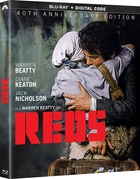BLU-RAY REVIEW

Reds
Featured In Issue 259, January/February 2022
"Reds" is the masterful political and historical epic centered on the Russian Revolution and the efforts to create socialism in the United States. The story is of a radical American activist/journalist John 'Jack" Reed (Warren Beatty) embroiled in the Bolshevik revolution. Throughout three is an engrossing depiction of the love story between Reed and Louise Bryant (Diane Keaton)set against the outbreak of World War I and the rise of communism in Russia. (Gary Reber)
Special features include the featurette "Witness To Reds" ((SD 67:32) ), the theatrical trailer, and a Movies Anywhere digital code.
The 1.85:1 1080p AVC picture, reviewed on a Sony Bravia Z9D 4K Ultra HD HDR display, upconverted to 2160p with greater resolution and luminance, was photographed on film and remastered from the original negative in 4K with HDR using a vintage print from the Paramount archives as a reference, which was approved by cinematographer Vittorio Storaro. The picture reveals little in the way of source element artifacts. The picture exhibits a strong grain structure, which conveys a filmic appearance, The color palette is strongly saturated with rich and warm primaries and hue nuances. There is a bronze filtered applied to stylize the palette, which intensifies brown hues. Flesh tones are rendered with natural complexions and warmth. Contrast is stylized as well with very deep dark levels and jet blacks, which tend to obscure shadow delineation. White levels are strong and brilliant. Resolution is generally good though there is an overall softness to the imagery, Still, fine detail manages to be revealed in clothing and objects. Storaro's cinematography is wonderful with the picture much like a series of rapid paintings. This is a beautiful film classic that is an epic. (Gary Reber)
The Dolby TrueHD 5.1-channel soundtrack was repurposed from the original monaural soundtrack, which is also provided. The soundtrack is front loaded with occasional subtle or aggressive enveloping surrounds, but does not provide much additional dimension over the original mono soundtrack. The surrounds are rarely used, and the front left and right channels are typically given the same mono signal (different from the center channel), which limit the stereo field's effectiveness. Dialogue is prominent throughout with generally good spatial integration. There is very little music with the story, which otherwise relies on the strength of the dialogue. Atmospherics are nuanced and occasional sound effects can be energized. Overall, the sound quality is dated. (Gary Reber)

 then "Add to Home Screen"
then "Add to Home Screen"